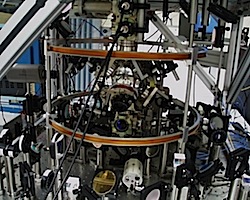Synchronization serves as a pacemaker for current and next-generation digital telecommunications networks, particularly cellular networks such as the CDMA2000 1xEV-DO system.
These networks with their large coverage areas, increased complexity, and high data rates call for precise and accurate time alignment of operations. For instance, according to IS-95/IS-2000 standard established by the Third Generation Partner Project 2 Technical Specification Group, CDMA network operators expect an accuracy of three microseconds per day from synchronization sources.
Synchronization serves as a pacemaker for current and next-generation digital telecommunications networks, particularly cellular networks such as the CDMA2000 1xEV-DO system.
These networks with their large coverage areas, increased complexity, and high data rates call for precise and accurate time alignment of operations. For instance, according to IS-95/IS-2000 standard established by the Third Generation Partner Project 2 Technical Specification Group, CDMA network operators expect an accuracy of three microseconds per day from synchronization sources.
Also, the European Telecommunications Standards Institute (ETSI) GSM 05.10 standard specifies a synchronization accuracy of 0.05 parts per million (ppm). Failing to achieve these requirements can result in dropped calls, spectrum violations, and corrupted data transmissions.
Due to their precision, GPS-based synchronizers (GBSes) have long been relied upon by such telecommunications systems for fulfilling their timing/frequency requirements and improving throughput and quality of service as a result. Key performance indicators of these communication systems depend upon their inter-network and intra-network synchronization, which is derived from these GPS-based synchronizers.
Other synchronization sources such as LORAN-C or atomic standards can also be used for timing/frequency requirements of high-speed communications networks. But, GBSes outperform such synchronization sources on the basis of better short-term and long-term stability, accuracy and precision in following Coordinated Universal Time (UTC), ease of deployment, availability of service, and, most importantly, cost. All these non-GPS-based synchronization sources are associated with such drawbacks as high installation, operations, and maintenance costs.
Given this growing dependence upon GPS-based timing capabilities, a corresponding increase has arisen in the need to understand the environmental and operational factors that can negatively affect the operation of GBSes. One such factor is radio frequency interference (RFI).
Although the effects of RFI on GNSS signal acquisition, tracking, and positioning accuracy have been studied extensively, its practical significance for precise timing and synchronization is less well understood. This article will examine how two forms of RFI — continuous wave and frequency modulation — affect the timing function in GPS receivers.
For the rest of this story, please download the complete article using the PDF link above.





